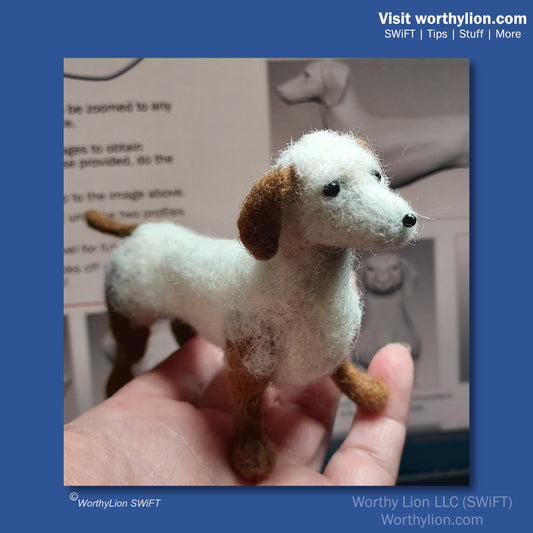Posing Tips
Posing breathes life into your sculptures.
Unfortunately, it does require a bit of talent to pull it off at a high level. But with practice, you can develop an eye for a good, realistic pose. The tips below can help you get there.
First, find an image of the animal you’re creating in a pose you like.
Put into words what you see:

- Back and head curved slightly.
- Head tilted very slightly.
- Left rear leg back, twisted out, and ready to step off if needed.
- Right rear leg under the hip and supporting the dog's weight.
- Front legs closer together at the base, and straight under supporting the chest.
What’s important is that the weight of the animal is supported, and the action (or potential action) flows through the body.
In the dog above, you can see the front legs support the forehand, and the forward rear leg supports the hips. The dog is alert and watching.
You try it with this cat.

What do you see in this pose?
The back is: _________________________
The head is: _________________________
The back legs are: ____________________
The front legs are: ____________________
The tail is: ___________________________
Here is what I came up with. It’s okay if you didn’t see everything I did. Just keep practicing by looking at photos and putting to words what you see.
Cat pose:
• The back is curved slightly from hips to shoulders increasing at the head.
• The head is twisted with the chin up.
• The legs are turned out with the hocks nearly touching.
• The tail forms a hook or question mark.
• The cat appears to be asking an unseen person “Is that my dinner?”
Critiquing others
When you view feltings done by others, critique the pose (privately and to yourself!) What have they done well? Is the animals' weight supported? Can you guess what the animal has just done or is about to do? What might you do differently? Critiquing the works of others is a main staple in art schools-because it works.
 Line of action
Line of action
Animals in motion have a flow. The movement starts with the eyes looking in a direction, the head turns if needed, then the neck stretches, the forelegs lean, and then a leg might start to take a step. If a strong action is needed (jump, leap, dropping down) the rear legs might compress a little or a lot loading the “springs” in the hips and hocks.

Eyes
The eyes should look in the direction of the action. The pupil should be turned with the whites showing if the turn is sharp enough. Not turning the eyes properly will leave the viewer with an odd feeling.

Portraits
Posing only the head may seem easier, but the details are important. The same rules apply in that the eyes need to be pointed correctly. A twist or tilt of the head needs to flow through the neck as it affects the muscles and fat from the nose on down the neck and into the chest.
If you add paws to the portrait, make sure they are in proportion to the head and you show enough of the neck to make it look right.
Start Learning the SWiFT Way of Needle Felting
Download the Free SWiFT Handbook and Two Free Project Sheets Today! | USA only. International visitors, please visit http://www.worthylion.etsy.com
-
Free Starter Bundle to Download
Regular price $0.00 USDRegular priceUnit price / per -
203BRP-B | Cute Kitten
Regular price $5.00 USDRegular priceUnit price / per -
401BRP-B | Cute Lamb
Regular price $5.00 USDRegular priceUnit price / per -
Dog: 118B | Dachshund | Standing
Regular price $5.00 USDRegular priceUnit price / per -
Horse: 303b | Jumping | Portrait
Regular price $5.00 USDRegular priceUnit price / per -
Marine: 512B | Sea Turtle | Swimming
Regular price $5.00 USDRegular priceUnit price / per -
Cat: 201B | Common | Portrait
Regular price $5.00 USDRegular priceUnit price / per -
Dog: 101B | Lab-type | Pre-posed | Sitting
Regular price $5.00 USDRegular priceUnit price / per -
Horse: 302B | Portrait
Regular price $5.00 USDRegular priceUnit price / per -
Dog: 116B | Boxer | Standing
Regular price $5.00 USDRegular priceUnit price / per



















